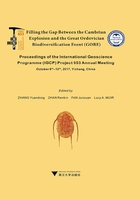
Geochemical Evidence for Ordovician Oxygenation:Another Driver of the ‘Great Ordovician Biodiversification Event’
Department of Geological and Environmental Sciences, Appalachian State University, Boone, NC 28608 USA;edwardsct4@appstate.edu
The Great Ordovician Biodiversification Event (GOBE) represents a four-fold increase of genus-level diversity and is generally thought of as a continuation of the ‘Cambrian Explosion' where hard part-secreting organisms are first widely preserved in the fossil record. A major increase in atmospheric oxygen (O2) levels is thought to be a leading cause of the ‘Cambrian Explosion' that lowered metabolic costs associated with skeletal biomineralization. The cause(s) of the GOBE, however, is (are) less well understood, and may include a cooling climate, increased nutrient availability, higher sea levels and increased ecospace, and further oxygenation of shallow marine environments. Atmospheric O2levels are difficult to quantitatively determine, particularly whether oxygenation was a plausible driver of the GOBE, because O2estimates are hampered in part by the coarse time resolution of isotope mass balance models and redox proxy records (e.g. iron-based geochemical data).
Recent investigations have focused on using high-resolution, multi proxy geochemical trends to better estimate the timing and degree of oxygenation across the GOBE. These proxies include traditional methods such as stable carbon (δ13C) and sulfur (δ34S) isotope trends as proxies of organic matter and pyrite burial, respectively, which are used in modeling approaches to track O2levels on a global scale. Other redox-sensitive proxies that are more reflective of changes in local to regional oxygen levels include iodine concentrations (I/Ca) and trace metal concentrations and isotopes (e.g. Fe, U, Mo, and Cr). Taken together, these forms of geochemical evidence suggest that Ordovician environments became progressively more oxygenated following the end of recurrent anoxic events and extinctions of late Cambrian and Early Ordovician marine faunas. Modeling studies suggest that atmospheric O2levels during the Early Ordovician were about half (~13%) of modern levels, and only after the Middle Ordovician (Darriwilian Stage) did O2levels steadily increase to 20%-25%, reaching near-modern levels by the Late Ordovician (Sandbian and early Katian stages). The timing of this oxygenation event roughly corresponds to the major pulses of biodiversification that comprise the GOBE, suggesting that oxygenation was an important driver of Ordovician biodiversity. Future studies aimed at investigating why this interval is key for both atmospheric O2levels and biodiversity should only help to better our understanding of the relationship between the climate and biosphere throughout deep time.